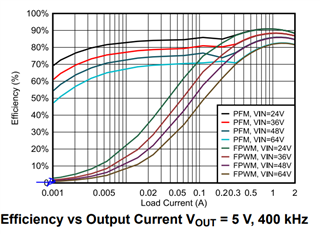Other Parts Discussed in Thread: LMR38020EVM
Hi,
I'm currently using the LMR38010FDDAR step-down converter. Is it expected for the device to consume about 2/3 W without a load attached?
Input voltage: 50 V DC
Output voltage: 3.3 V DC
Switching Frequency: Set to ~1.3 MHz (20k ohm resistor)
Inductor: 15 uH
With a 30 ohm load attached, power draw in total is a little larger than 1 W. Similar results with a switching frequency set to about 400 KHz (less power consumed, but enough to still make the chip warm).
Best



